When Xiao Bian was very young, he liked to run to the balcony to watch fireworks every New Year. After a bang, a bright and colorful fireworks burst into the distant sky, gorgeous and beautiful.
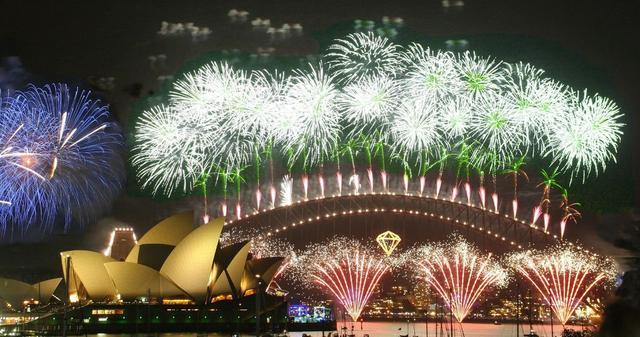
All kinds of fireworks @Wikipedia
Therefore, Xiao Bian, who was young and ignorant at that time, couldn’t help wondering … Why did a small box on the ground look like that after being ignited? How on earth are fireworks designed and made in order to show such a brilliant effect?

The picture comes from the Internet.
There are many kinds of fireworks, and the fireworks seen in general TV programs, that is, the kind that flies to the sky with a bang and then explodes, are a special kind of fireworks called fireworks.
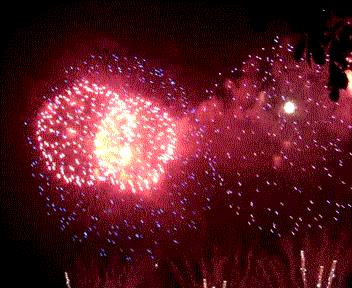
Fireworks @Wikipedia
Fireworks bloom can be roughly divided into two stages. The first stage is the launch of the fireworks bomb: with a bang, something on the ground flew into the sky. The second stage is probably the burst of fireworks, and a firework exploded in the sky. What happened in these two stages respectively?
The internal structure of a certain kind of fireworks is probably like this [1].
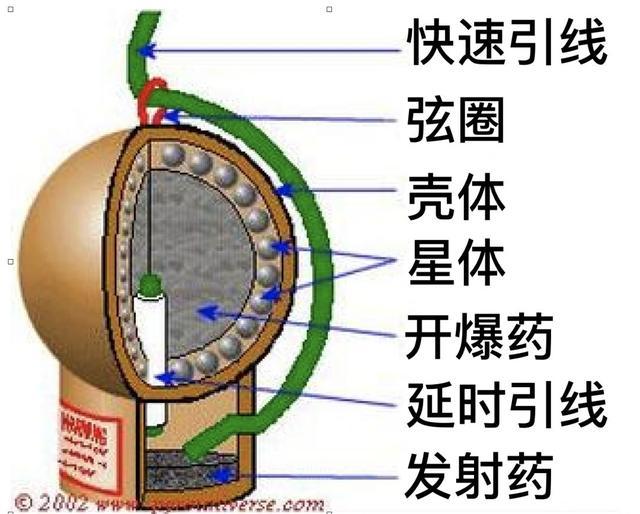
Fireworks structure @pyrouniverse.com
Hit the fireworks into the sky
When we lit the fuse (fast fuse), the fuse gave the friends time to evacuate and delayed the explosion. When the fuse burns to the propellant, ignite the propellant. Propellant is generally black powder discovered by the ancient alchemist in China. After the fireworks are lit, the sound of "bang" is the explosion of this thing. The main components of black powder are sulfur, charcoal and potassium nitrate, and the reaction formula of explosion is complicated. A typical chemical reaction equation looks like this (familiar with one sulfur, two nitrates and three carbons):
This explosion reaction produces a lot of heat and high-temperature gas, which is similar to the principle of rocket launch. The high-temperature gas produces huge thrust and pushes the shell into the sky. In the process of flying high into the air, we often hear the whistling sound, which is a sound effect of fireworks. It comes from a special thermal-acoustic coupling combustion-pulsating combustion.
Pulsating combustion
Pulsating combustion is a special unstable combustion process, and the parameters such as temperature, pressure and airflow speed in the combustion zone will fluctuate periodically with time. In the process of industrial application of pulsating combustion, there will be a lot of noise radiated from the tail pipe of the burner [2]. This technology involves many nonlinear processes of thermo-acoustic coupling, large amplitude acoustic wave effect and so on, which is very complicated, so there is no relevant theory at present [3].

But the fact that there is no relevant theory doesn’t mean that we are not here or can’t use it.
People engaged in fireworks production already know that in order to make fireworks produce this whistling sound, it is necessary to use a special kind of combustion product-flute agent. Oxidizers (potassium perchlorate and potassium chlorate) and flute agents (mainly derivatives of benzene) are mixed and packed into paper or plastic tubes, and pulsating combustion will occur after ignition, resulting in crisp flute sound [4].
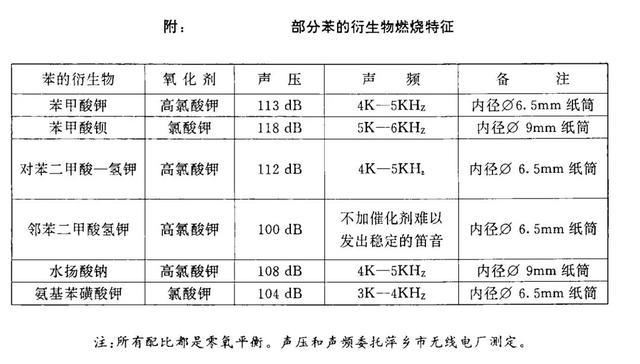
@ References [4]
This pulsating combustion causes thousands of violent vibrations of air every second, releasing high-frequency sound waves. Therefore, the combustion chamber loaded with flute agent and oxidant acts as a propeller, and at the same time, it also emits a sharp whistle-like sound.
In addition to the fireworks launched, there is also a famous fireworks with sound. Xiaobian’s hometown likes to call him a monkey, which is this thing:
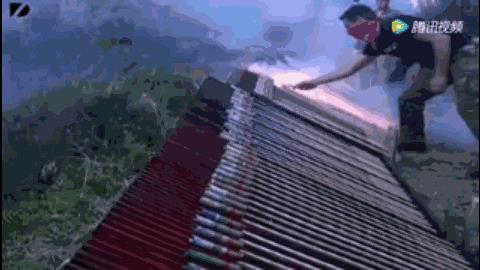
@bilibili-av8389766
The ingredients of the propellant used in this kind of thing are potassium perchlorate and potassium hydrogen phthalate. And this potassium hydrogen phthalate, as can be seen from the above table, is also a flute agent (although the sound frequency emitted by combustion is unstable, it still produces a sound pressure of 100dB).
Burst out a firework.
After the propellant is detonated, the delay lead is ignited and the time is started. By the time the shell flies to high altitude and needs to be ignited, the delay lead is almost burned out. So the explosive was detonated and the stars were blown all over the sky. The figure of the fireworks explosion depends on the position of the stars in the shell. If the medicine makes the fireworks explode into a specific shape, it is necessary to design the arrangement of the stars in the fireworks subtly [5].
What the hell is this star? It is the most crucial and mysterious part of the whole fireworks display ~
Its main components are magnesium powder, potassium perchlorate and metal salt or metal powder [6].
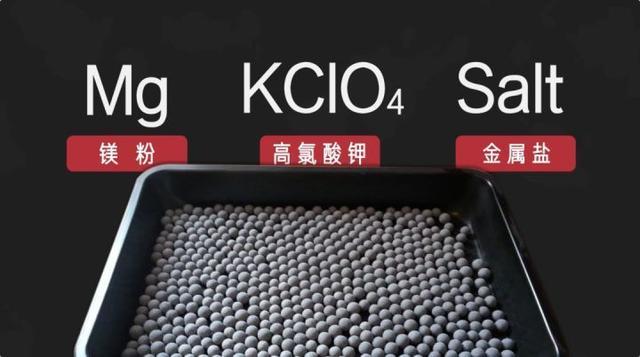
Star Composition @ Paperclip-How to Make Explosive Fireworks
After the star is ignited, magnesium powder as reducing agent and potassium perchlorate as oxidizing agent burn violently, giving off a lot of light and heat (but not gas) and becoming the shining things in the fireworks.
But how did the colors of fireworks come from? This involves an important phenomenon related to physics and chemistry-flame reaction.
flame reaction
Simple metals or their compounds will evaporate into individual particles at extremely high temperature, and only individual particles can exhibit flame reaction. (There is no flame reaction in bulk solid samples, because the luminescence of bulk materials is mainly related to the movement of electrons in the materials, and there are various electrons in different movement states in bulk solid samples, so the spectrum of light emitted by bulk materials is very wide and does not present a relatively single color [7]). However, the free metal simple substance or metal ion in the flame will be excited to an excited state with higher energy at high temperature.
However, the excited atom at higher energy is unstable, and it will always transition to the most stable ground state with the lowest energy. In this process, the photon energy (hν) emitted by the atom is exactly equal to the energy difference between the excited state (energy E2) and the ground state (energy E1).

@Wikipedia
The wavelength of photons emitted in this way does not depend on the temperature of the evaporated metal particles, but only on the energy difference between the two energy levels where the transition occurs, and this energy difference is only related to the kind of atoms.
Therefore, different metal ions will have different colors. In this way, we can use various metals and metal compounds to produce various colors.
The metals or metal compounds in the stars, heated by the huge heat released by the burning of magnesium and potassium perchlorate, emit their own light through the flame reaction.

The color of flame reaction [8]
tag
It’s been more than a dozen Spring Festival from a silly child who knows nothing to today’s Xiaobian. Looking at the manuscript, I can’t help but think of myself skipping in front of fireworks more than ten years ago. Time flies, the sun and the moon fly. Although it is more and more difficult to see the fireworks bloom, their physical and chemical principles are becoming more and more clear.
Anyway, it’s the Spring Festival. While enjoying the beautiful and gorgeous fireworks, don’t miss the same beautiful and gorgeous physical and chemical principles behind the fireworks ~
Ps: Places where fireworks and firecrackers are prohibited should strictly abide by the regulations.
reference data
[1] https://steemit.com/science/@xenvy04/the-chemistry-of-fireworks-happy-fourth-of-july
Shao Dongwei, Wang Junfa, Liu Yuanjun, et al. Research and application of pulsating combustion technology [J]. Modern Agriculture, 2009 (7):41-43.
Wu Yunfei, Deng Kai, Shen Zhongliang, et al. Development of pulsating combustion technology [J]. Light Industry Machinery, 2013 (1):106-110.
Lan Haikang. The relationship between flute agent and chemical structure [J]. Fireworks Technology and Market, 1994(1):20-21.
[5] https://zhuanlan.zhihu.com/p/86164747
[6] How to make explosive fireworks
[7] https://en.wikipedia.org/wiki/Flame_test
[8] https://www.compoundchem.com/2013/12/30/the-chemistry-of-fireworks/
Editor: Luna
Reporting/feedback